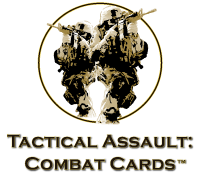How Do I… Historical Units
One question about the Combat Cards that comes up a lot from history buffs, is how to match historical units with the specific Unit Types when playing a historical battle or scenario. Sometimes it just doesn’t feel right to assign Armored Unit status to what was essentially a light tank, just because it was called a “tank”. Often in reality, units performed so poorly in the roles they were designed for – either due to design flaws or obsolescence – that they were not employed in the originally intended fashion. So how is this worked into the Combat Cards?
The secret is when deciding what Unit Type to assign to a specific model, think more in terms of what the unit’s actual role on the battlefield was at the time of the battle, rather than in terms of the unit’s official title. Odds are there is a Unit Type classification in the game that will fit the unit’s actual role just perfectly.
For example, In World War II there were several towed anti-tank guns that were state of the art at the beginning of the war, but were essentially obsolete by the war’s later stages. Despite the obvious obsolescence, many nations still continued to use these weapons right up to the end of hostilities. Due to their reduced effectiveness against ever improving tanks though, their role became more one of infantry support rather than one of a true anti-tank weapon.
When incorporating one of these types of guns into your forces for an early war battle, you would most likely classify it as an Anti-Armor Unit. That was its role at the time, and it performed adequately in that role. When using it in a later war scenario though, it would probably be more accurate to classify it as a Heavy Weapon Unit. It would still capable of firing at armored units, but it would not be as effective given the Heavy Weapon Unit Characteristics – a fairly accurate representation of what really occured.
Another example that comes from World War II are light tanks. While many of these were very fast and powerful in the pre-war period, as the war dragged on they were definitely outclassed and could no longer realistically be used as tanks (or Armored Units in the Combat Cards). Here again, think in terms of the unit’s role in the later stages of the war when assigning a Unit Type to it.
Often those light tanks were assigned reconnaissance missions later in the war, so you could assign it the Recon Unit type. If the tank was particularly slow, but perhaps had a good gun, it could be classified as an Anti-Armored Unit. Or if the gun was weak, the movement slow and the armor was thin, maybe just assigning it the Heavy Weapons Unit Status would be appropriate. Any of these options would be a good a way to represent the unit on the battlefield.
Now in case where units are contemporaries, but are grossly different in the capabilities, the same principles apply – you just may have to be a little more open minded in your approach to assigning units. One example that comes to mind occurred during the first Gulf War in 1991. American M1A2 tanks encounter Iraqi T-72 main battle tanks during the battle of 73 Easting. Now, while both of these types of tanks are technically classified as “main battle tanks” there were obvious differences in the technological sophistication, firepower and crew training. To reflect these discrepancies in a battle using the Combat Cards, you could simply classify the T-72’s as Armored Units as normal and then assign the M1A2 tanks the Behemoth Units status to give them a distinct edge (namely in Firepower and Protection).
As you can see, when you are laying out historical scenarios it really isn’t too hard to find a good fit between the Combat Cards’ Unit Types and their historical counterparts. It just takes a little critical thinking about the unit’s actual role on the battlefield, the difference between its capabilities and those of its enemies, and then a little open mindedness on the assigning of Unit Types. All of which will yield a game which realistically represents the interaction of those units on the battlefield within the framework of the Combat Cards.





